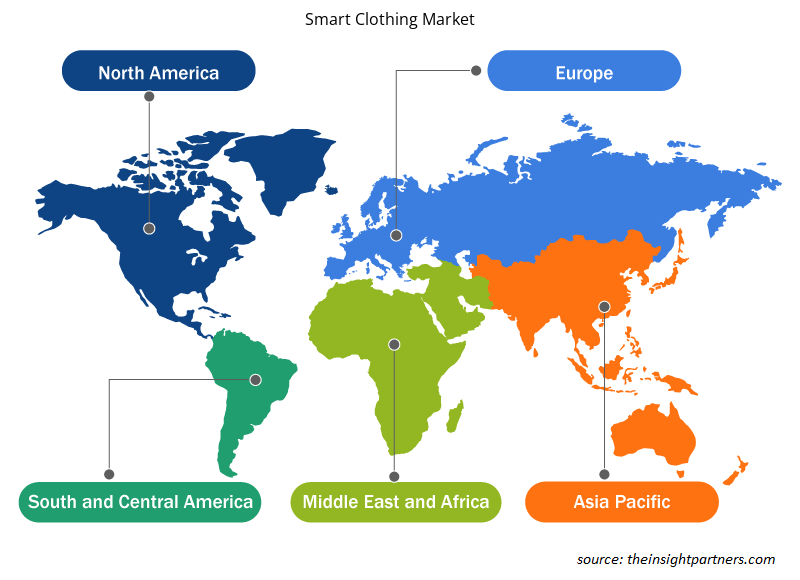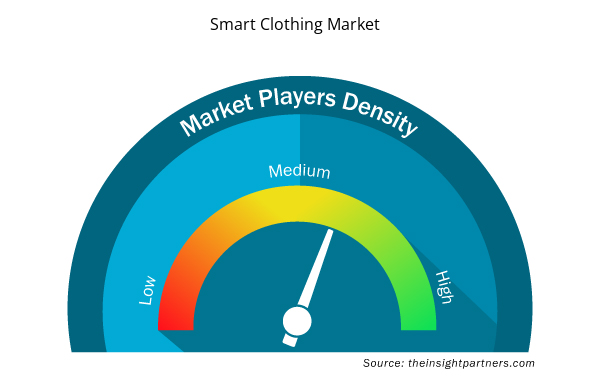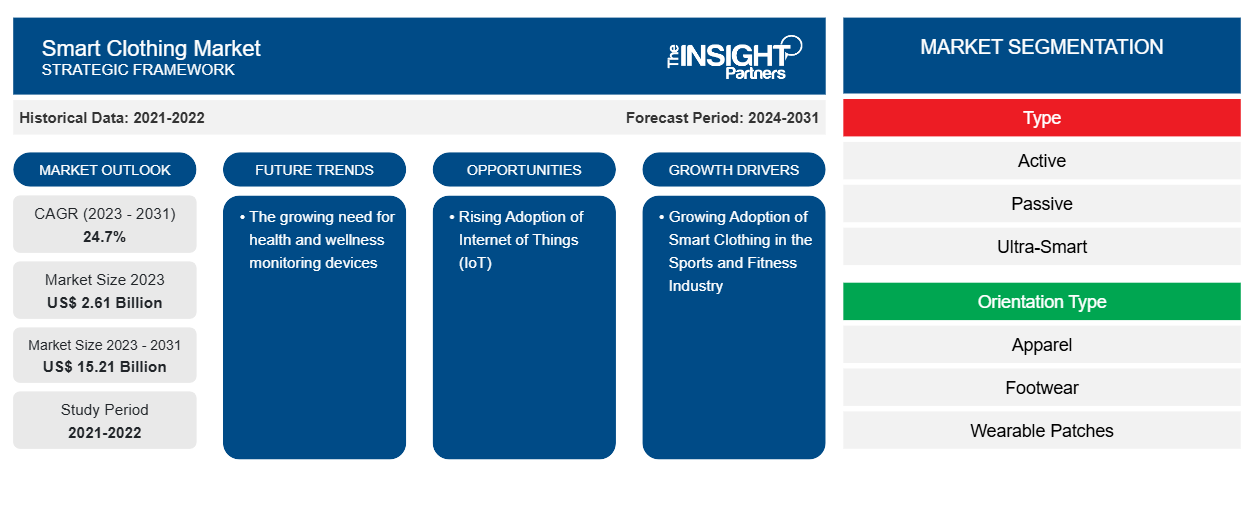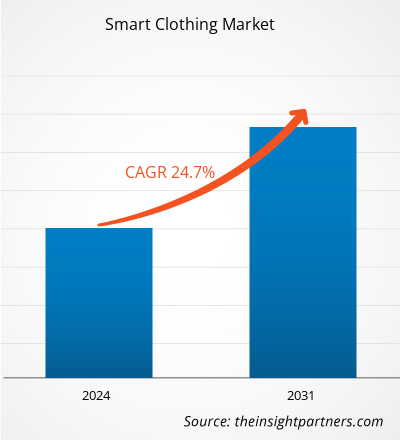Se prevé que el tamaño del mercado de ropa inteligente alcance los 15.210 millones de dólares en 2031, frente a los 2.610 millones de dólares en 2023. Se espera que el mercado registre una CAGR del 24,7 % entre 2023 y 2031. Es probable que la creciente necesidad de dispositivos de control de la salud y el bienestar siga siendo una tendencia clave en el mercado de la ropa inteligente.
Análisis del mercado de ropa inteligente
El mercado de la ropa inteligente está creciendo a un ritmo rápido debido a la creciente adopción de prendas inteligentes en la industria del deporte y el fitness y la creciente adopción de sensores para monitorear las actividades corporales. El mercado se está expandiendo de manera constante, impulsado por la creciente adopción de dispositivos portátiles. Además, la creciente adopción de Internet de las cosas ( IoT ) está brindando oportunidades lucrativas para el crecimiento del mercado.
Panorama del mercado de ropa inteligente
La ropa inteligente incorpora componentes electrónicos para mejorar la utilidad y la conectividad. Estas prendas pueden recopilar datos biométricos , medir los niveles de actividad, regular la temperatura e incluso proporcionar retroalimentación háptica. El mercado de la ropa inteligente ofrece prendas revolucionarias con sensores y tecnologías que revolucionan el uso diario. Estas prendas mejoran la gestión de la salud y el estilo de vida, incluido el seguimiento del estado físico y la monitorización biométrica . Proporcionan datos en tiempo real, lo que permite a los usuarios tomar decisiones informadas sobre su salud. El uso de textiles inteligentes en la moda no solo mejora la comodidad, sino que también fomenta un enfoque proactivo de la salud, lo que aumenta la demanda entre los consumidores. Por lo tanto, impulsa el mercado.
Personalice este informe según sus necesidades
Obtendrá personalización en cualquier informe, sin cargo, incluidas partes de este informe o análisis a nivel de país, paquete de datos de Excel, así como también grandes ofertas y descuentos para empresas emergentes y universidades.
- Obtenga las principales tendencias clave del mercado de este informe.Esta muestra GRATUITA incluirá análisis de datos, desde tendencias del mercado hasta estimaciones y pronósticos.
Factores impulsores y oportunidades del mercado de ropa inteligente
La creciente adopción de ropa inteligente en la industria del deporte y el fitness está impulsando el mercado
La ropa inteligente tiene un enorme potencial en la industria del deporte y el fitness. Los deportistas y los entusiastas del fitness están adoptando con fuerza la ropa inteligente debido a sus beneficios, como el control en tiempo real de datos fisiológicos como la saturación de oxígeno, la actividad muscular, la frecuencia cardíaca y los patrones de movimiento. Estos datos son útiles para perfeccionar los programas de entrenamiento, reducir los riesgos de lesiones y mejorar el rendimiento general. Además, los equipos inteligentes brindan información sobre la postura, la técnica y la forma, lo que permite a los deportistas realizar modificaciones y mejorar sus rutinas de ejercicio. La integración de la ropa inteligente con dispositivos portátiles y aplicaciones móviles ayuda a los usuarios a crear un ecosistema de fitness holístico que brinda información y recomendaciones individualizadas a los usuarios que buscan mejorar sus objetivos de salud.
La creciente adopción de Internet de las cosas ( IoT ): una oportunidad en el mercado de la ropa inteligente
El crecimiento del IoT permite la integración perfecta de prendas inteligentes con teléfonos inteligentes y relojes inteligentes. Esta conectividad mejora las experiencias de los usuarios y permite nuevas funcionalidades, lo que se espera que cree oportunidades en el mercado. La proliferación del IoT hace que la ropa inteligente sea una parte cada vez más importante del ecosistema interconectado, proporcionando a los usuarios una comodidad y variedad incomparables en su vida diaria. Además, la creciente demanda de ropa inteligente anima a los fabricantes a desarrollar soluciones tecnológicamente avanzadas para satisfacer las demandas de los consumidores. Por ejemplo, en abril de 2023, los investigadores de la Universidad de Waterloo crearon un innovador "tejido inteligente" hecho de fibras nanocompuestas de polímero incrustadas con cables de acero inoxidable. Este tejido tiene una respuesta particular al calor y la electricidad, con cables incrustados que se contraen y cambian de forma cuando se calientan.
Análisis de segmentación del informe de mercado de ropa inteligente
Los segmentos clave que contribuyeron a la derivación del análisis del mercado de ropa inteligente son el tipo, el tipo de orientación, la conectividad y el usuario final.
- Según el tipo, el mercado de ropa inteligente se divide en activo, pasivo y ultrainteligente. El segmento activo tuvo una mayor participación de mercado en 2023.
- En términos de tipo de orientación, el mercado está segmentado en prendas de vestir, calzado, parches portátiles y otros. El segmento de prendas de vestir tuvo una mayor participación de mercado en 2023.
- En función de la conectividad, el mercado de ropa inteligente se divide en Wi-Fi, Bluetooth, GPS y RFID. El segmento GPS tuvo una mayor participación de mercado en 2023.
- En términos de usuario final, el mercado se clasifica en atención médica, moda y estilo de vida, deporte y fitness, militar y otros. El segmento de deporte y fitness tuvo una mayor participación de mercado en 2023.
Análisis de la cuota de mercado de ropa inteligente por geografía
El alcance geográfico del informe del mercado de ropa inteligente se divide principalmente en cinco regiones: América del Norte, Asia Pacífico, Europa, Medio Oriente y África, y América del Sur/América del Sur y Central.
En términos de ingresos, América del Norte representó la mayor participación en el mercado de ropa inteligente, debido a la favorable iniciativa gubernamental para promover la tecnología de ropa inteligente. Por ejemplo, en septiembre de 2023, el gobierno de EE. UU. invirtió 22 millones de dólares para promover la iniciativa de pantalones electrónicos inteligentes para avanzar en la tecnología de ropa de vigilancia inteligente. El gobierno planea crear prendas portátiles que rastrean la geolocalización, graban audio y video y monitorean datos fisiológicos para el personal militar y las agencias de inteligencia. Esto aumenta el conocimiento de la situación y la recopilación de datos en entornos peligrosos.
Perspectivas regionales del mercado de ropa inteligente
Los analistas de Insight Partners explicaron en detalle las tendencias y los factores regionales que influyen en el mercado de ropa inteligente durante el período de pronóstico. Esta sección también analiza los segmentos y la geografía del mercado de ropa inteligente en América del Norte, Europa, Asia Pacífico, Oriente Medio y África, y América del Sur y Central.

- Obtenga datos regionales específicos para el mercado de ropa inteligente
Alcance del informe sobre el mercado de ropa inteligente
| Atributo del informe | Detalles |
|---|---|
| Tamaño del mercado en 2023 | US$ 2.61 mil millones |
| Tamaño del mercado en 2031 | US$ 15,21 mil millones |
| CAGR global (2023 - 2031) | 24,7% |
| Datos históricos | 2021-2022 |
| Período de pronóstico | 2024-2031 |
| Segmentos cubiertos | Por tipo
|
| Regiones y países cubiertos | América del norte
|
| Líderes del mercado y perfiles de empresas clave |
|
Densidad de actores del mercado de ropa inteligente: comprensión de su impacto en la dinámica empresarial
El mercado de ropa inteligente está creciendo rápidamente, impulsado por la creciente demanda de los usuarios finales debido a factores como la evolución de las preferencias de los consumidores, los avances tecnológicos y una mayor conciencia de los beneficios del producto. A medida que aumenta la demanda, las empresas amplían sus ofertas, innovan para satisfacer las necesidades de los consumidores y aprovechan las tendencias emergentes, lo que impulsa aún más el crecimiento del mercado.
La densidad de actores del mercado se refiere a la distribución de las empresas o firmas que operan dentro de un mercado o industria en particular. Indica cuántos competidores (actores del mercado) están presentes en un espacio de mercado determinado en relación con su tamaño o valor total de mercado.
Las principales empresas que operan en el mercado de ropa inteligente son:
- Ropa inteligente AiQ Inc.
- Carve Technologies Inc. (Hexoskin)
- CIRCUITO LINDO
- Applycon, sro
- Compañía Jabil Inc.
- Myontec Ltd
Descargo de responsabilidad : Las empresas enumeradas anteriormente no están clasificadas en ningún orden particular.

- Obtenga una descripción general de los principales actores clave del mercado de ropa inteligente
Noticias y desarrollos recientes del mercado de ropa inteligente
El mercado de ropa inteligente se evalúa mediante la recopilación de datos cualitativos y cuantitativos a partir de una investigación primaria y secundaria, que incluye publicaciones corporativas importantes, datos de asociaciones y bases de datos. A continuación, se incluye una lista de los avances en el mercado de ropa inteligente y las estrategias:
- En abril de 2023, H & M Hennes & Mauritz GBC AB colaboró con LanzaTech para ofrecer a sus clientes una colección cápsula elaborada con poliéster CarbonSmart, un material innovador que utiliza emisiones de carbono reutilizadas. Esta asociación permite a H&M Move explorar materiales innovadores y contribuir a crear ropa deportiva inteligente y más sostenible en el futuro. (Fuente: H & M Hennes & Mauritz GBC AB, comunicado de prensa, 2023)
Informe sobre el mercado de ropa inteligente: cobertura y resultados
El informe “Tamaño y pronóstico del mercado de ropa inteligente (2021-2031)” proporciona un análisis detallado del mercado que cubre las siguientes áreas:
- Tamaño del mercado y pronóstico a nivel global, regional y nacional para todos los segmentos clave del mercado cubiertos bajo el alcance
- Dinámica del mercado, como impulsores, restricciones y oportunidades clave
- Principales tendencias futuras
- Análisis detallado de las cinco fuerzas de Porter y PEST y FODA
- Análisis del mercado global y regional que cubre las tendencias clave del mercado, los principales actores, las regulaciones y los desarrollos recientes del mercado.
- Análisis del panorama de la industria y de la competencia que abarca la concentración del mercado, el análisis de mapas de calor, los actores destacados y los desarrollos recientes
- Perfiles detallados de empresas
- Análisis histórico (2 años), año base, pronóstico (7 años) con CAGR
- Análisis PEST y FODA
- Tamaño del mercado Valor/volumen: global, regional, nacional
- Industria y panorama competitivo
- Conjunto de datos de Excel



Report Coverage
Revenue forecast, Company Analysis, Industry landscape, Growth factors, and Trends

Segment Covered
This text is related
to segments covered.

Regional Scope
North America, Europe, Asia Pacific, Middle East & Africa, South & Central America

Country Scope
This text is related
to country scope.
Preguntas frecuentes
The incremental growth expected to be recorded for the global smart clothing market during the forecast period is US$ 12.60 billion.
The global smart clothing market is expected to reach US$ 15.21 billion by 2031.
The key players holding majority shares in the global smart clothing market are AiQ Smart Clothing Inc., Carve Technologies Inc. (Hexoskin), CUTECIRCUIT, Applycon, s. r. o., and Jabil Inc.
The growing need for health and wellness monitoring devices to play a significant role in the global smart clothing market in the coming years.
The growing adoption of smart clothing in the sports and fitness industry and the increasing adoption of sensors for monitoring bodily activities are the major factors that propel the global smart clothing market.
The global smart clothing market was estimated to be US$ 2.61 billion in 2023 and is expected to grow at a CAGR of 24.7% during the forecast period 2023 - 2031.
Trends and growth analysis reports related to Electronics and Semiconductor : READ MORE..
The Insight Partners performs research in 4 major stages: Data Collection & Secondary Research, Primary Research, Data Analysis and Data Triangulation & Final Review.
- Data Collection and Secondary Research:
As a market research and consulting firm operating from a decade, we have published and advised several client across the globe. First step for any study will start with an assessment of currently available data and insights from existing reports. Further, historical and current market information is collected from Investor Presentations, Annual Reports, SEC Filings, etc., and other information related to company’s performance and market positioning are gathered from Paid Databases (Factiva, Hoovers, and Reuters) and various other publications available in public domain.
Several associations trade associates, technical forums, institutes, societies and organization are accessed to gain technical as well as market related insights through their publications such as research papers, blogs and press releases related to the studies are referred to get cues about the market. Further, white papers, journals, magazines, and other news articles published in last 3 years are scrutinized and analyzed to understand the current market trends.
- Primary Research:
The primarily interview analysis comprise of data obtained from industry participants interview and answers to survey questions gathered by in-house primary team.
For primary research, interviews are conducted with industry experts/CEOs/Marketing Managers/VPs/Subject Matter Experts from both demand and supply side to get a 360-degree view of the market. The primary team conducts several interviews based on the complexity of the markets to understand the various market trends and dynamics which makes research more credible and precise.
A typical research interview fulfils the following functions:
- Provides first-hand information on the market size, market trends, growth trends, competitive landscape, and outlook
- Validates and strengthens in-house secondary research findings
- Develops the analysis team’s expertise and market understanding
Primary research involves email interactions and telephone interviews for each market, category, segment, and sub-segment across geographies. The participants who typically take part in such a process include, but are not limited to:
- Industry participants: VPs, business development managers, market intelligence managers and national sales managers
- Outside experts: Valuation experts, research analysts and key opinion leaders specializing in the electronics and semiconductor industry.
Below is the breakup of our primary respondents by company, designation, and region:

Once we receive the confirmation from primary research sources or primary respondents, we finalize the base year market estimation and forecast the data as per the macroeconomic and microeconomic factors assessed during data collection.
- Data Analysis:
Once data is validated through both secondary as well as primary respondents, we finalize the market estimations by hypothesis formulation and factor analysis at regional and country level.
- Macro-Economic Factor Analysis:
We analyse macroeconomic indicators such the gross domestic product (GDP), increase in the demand for goods and services across industries, technological advancement, regional economic growth, governmental policies, the influence of COVID-19, PEST analysis, and other aspects. This analysis aids in setting benchmarks for various nations/regions and approximating market splits. Additionally, the general trend of the aforementioned components aid in determining the market's development possibilities.
- Country Level Data:
Various factors that are especially aligned to the country are taken into account to determine the market size for a certain area and country, including the presence of vendors, such as headquarters and offices, the country's GDP, demand patterns, and industry growth. To comprehend the market dynamics for the nation, a number of growth variables, inhibitors, application areas, and current market trends are researched. The aforementioned elements aid in determining the country's overall market's growth potential.
- Company Profile:
The “Table of Contents” is formulated by listing and analyzing more than 25 - 30 companies operating in the market ecosystem across geographies. However, we profile only 10 companies as a standard practice in our syndicate reports. These 10 companies comprise leading, emerging, and regional players. Nonetheless, our analysis is not restricted to the 10 listed companies, we also analyze other companies present in the market to develop a holistic view and understand the prevailing trends. The “Company Profiles” section in the report covers key facts, business description, products & services, financial information, SWOT analysis, and key developments. The financial information presented is extracted from the annual reports and official documents of the publicly listed companies. Upon collecting the information for the sections of respective companies, we verify them via various primary sources and then compile the data in respective company profiles. The company level information helps us in deriving the base number as well as in forecasting the market size.
- Developing Base Number:
Aggregation of sales statistics (2020-2022) and macro-economic factor, and other secondary and primary research insights are utilized to arrive at base number and related market shares for 2022. The data gaps are identified in this step and relevant market data is analyzed, collected from paid primary interviews or databases. On finalizing the base year market size, forecasts are developed on the basis of macro-economic, industry and market growth factors and company level analysis.
- Data Triangulation and Final Review:
The market findings and base year market size calculations are validated from supply as well as demand side. Demand side validations are based on macro-economic factor analysis and benchmarks for respective regions and countries. In case of supply side validations, revenues of major companies are estimated (in case not available) based on industry benchmark, approximate number of employees, product portfolio, and primary interviews revenues are gathered. Further revenue from target product/service segment is assessed to avoid overshooting of market statistics. In case of heavy deviations between supply and demand side values, all thes steps are repeated to achieve synchronization.
We follow an iterative model, wherein we share our research findings with Subject Matter Experts (SME’s) and Key Opinion Leaders (KOLs) until consensus view of the market is not formulated – this model negates any drastic deviation in the opinions of experts. Only validated and universally acceptable research findings are quoted in our reports.
We have important check points that we use to validate our research findings – which we call – data triangulation, where we validate the information, we generate from secondary sources with primary interviews and then we re-validate with our internal data bases and Subject matter experts. This comprehensive model enables us to deliver high quality, reliable data in shortest possible time.


 Obtenga una muestra gratuita de este informe
Obtenga una muestra gratuita de este informe